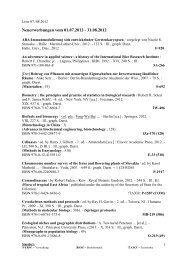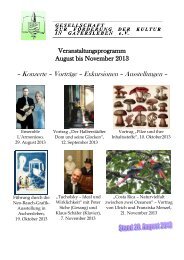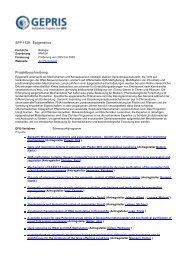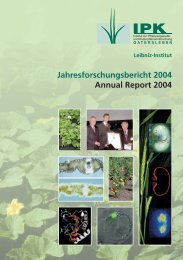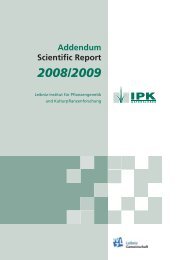Research Group - IPK Gatersleben
Research Group - IPK Gatersleben
Research Group - IPK Gatersleben
Create successful ePaper yourself
Turn your PDF publications into a flip-book with our unique Google optimized e-Paper software.
Abteilung Genbank/Department of Genebank<br />
when applied to experimentally verified sequences using<br />
a 10,000-fold stratified holdout sampling procedure. The<br />
most promising model turned out to be a Bayesian tree,<br />
yielding an estimate of 75 ± 15 haplotypes for a population<br />
with 13,799 accessions. Using passport data as well<br />
as characterisation and evaluation data, the error bars<br />
of the estimates could be further reduced and lead to<br />
the conclusion that stratification by resistance and origin<br />
provided the subsets with the highest predicted fraction<br />
of novel haplotypes per 1,000 accessions (J. Keilwagen).<br />
Genome and segmental duplications are common<br />
in the plant kingdom, and the detection and evolutionary<br />
analysis of duplications in the barley genome can<br />
advance our understanding of genome evolution in the<br />
grass family with implications for molecular breeding in<br />
barley. The barley-rice synteny model was extended by<br />
integrating 1,0 6 Illumina markers based on the HarvEST<br />
#3 assembly into the existing <strong>IPK</strong> barley transcript map<br />
of barley comprising approximately 1,000 EST markers. It<br />
was found that 90 % of the markers show sequence homology<br />
to rice, and 50 % of them are located in syntenic<br />
regions of barley and rice, covering 80 % of the barley<br />
genetic map and 60 % of the rice genome, respectively.<br />
Using the extended barley-rice synteny model together<br />
with evidence from (i) measurements of synonymous and<br />
non-synonymous substitution rates as well as (ii) the location<br />
of second-best homologs of barley genes, it could be<br />
inferred that 40 % of the barley genome covered by the<br />
barley genetic map shows traces of genome duplications<br />
originating from the common ancestor of barley and rice<br />
(see Fig. 9, p. 7) (T. Thiel).<br />
Several transcription factors responsible for the regulation<br />
of seed development in Arabidopsis thaliana were<br />
studied by ChIP/chip experiments within the trilateral<br />
project ARABIDO-SEED. A software pipeline for the efficient<br />
analysis of the ChIP/chip data and gene expression<br />
data generated by all of the participating partners from<br />
Spain, France, and Germany was developed in collaboration<br />
with the research groups Expression Mapping, Gene<br />
Regulation, and Phytoantibodies as well as with the other<br />
external partners of the project. This pipeline allows<br />
a normalisation of the ChIP/chip data and a prediction<br />
of putative target genes as well as subsequent analyses<br />
of gene expression data and conserved DNA motifs. The<br />
pipeline was designed such that it can handle ChIP/chip,<br />
expression, and sequence data from different projects<br />
and different species (M. Seifert).<br />
The prediction of novel binding sites in the promoters<br />
bound by the studied transcription factors was one of the<br />
main goals of the trilateral project ARABIDO-SEED. The<br />
previously developed EMMA algorithm, which extends<br />
the widely used MEME algorithm, was extended in multiple<br />
directions. Motivated by the fact that ChIP/chip data<br />
as well as expression data are intrinsically noisy, the algorithm<br />
now allows that promoters may or may not contain<br />
40<br />
binding sites. The user may specify either the expected<br />
percentage of promoters containing a binding site or, for<br />
each of the studied promoters individually, the probability<br />
of containing a binding site. Such probabilities can be obtained,<br />
for example, from the analysis pipeline described<br />
above. A second extension improves the recognition of<br />
binding sites with correlated nucleotides by recruiting<br />
Variable-Order Markov models, Bayesian networks, and<br />
Variable-Order Bayesian networks. A third extension allows<br />
the prediction of cis-regulatory modules, consisting<br />
of multiple binding sites with variable composition, spacing,<br />
and orientation (M. Mohr).<br />
Today, the Plant Data Warehouse is a useful software platform<br />
for the integration and analysis of molecular, phenotypic,<br />
and taxonomic data as well as data on plant genetic<br />
resources. Currently, it is used more than 1,000 times per<br />
month, and its future maintenance is secured by the research<br />
group Bioinformatics and Information Technology.<br />
T. Funke, C. Künne, and S. Mielordt continue their careers<br />
in industry, J. Keilwagen, M. Mohr, M. Seifert, and T. Thiel<br />
continue their PhD studies at <strong>IPK</strong>, and I. Große continues<br />
his work at the Martin Luther University Halle-Wittenberg.<br />
Collaboration<br />
Within the Institute:<br />
Dept. of Genebank, <strong>Research</strong> <strong>Group</strong> Genome Diversity;<br />
Prof. A. Graner;<br />
Dept. of Genebank, <strong>Research</strong> <strong>Group</strong> Genebank Documentation;<br />
Dr. H. Knüpffer;<br />
Dept. of Genebank, <strong>Research</strong> <strong>Group</strong> In vitro Storage and<br />
Cryopreservation; Dr. J. Keller;<br />
Dept. of Genebank, External Branch “North”;<br />
Dr. K.J. Dehmer;<br />
Dept. of Genebank, <strong>Research</strong> Goup Quantitative Evolutionary<br />
Genetics; Dr. K. Schmid;<br />
Dept. of Genebank, <strong>Research</strong> <strong>Group</strong> Taxonomy of Plant<br />
Genetic Resources; Dr. R. Fritsch;<br />
Dept. of Cytogenetics and Genome Analysis, <strong>Research</strong><br />
<strong>Group</strong> Expression Mapping; Dr. L. Altschmied;<br />
Dept. of Cytogenetics and Genome Analysis, <strong>Research</strong><br />
<strong>Group</strong> Bioinformatics and Information Technology;<br />
Dr. U. Scholz;<br />
Dept. of Molecular Genetics, <strong>Research</strong> <strong>Group</strong> Gene Regulation;<br />
Dr. H. Bäumlein;<br />
Dept. of Molecular Genetics, <strong>Research</strong> <strong>Group</strong> Phytoantibodies;<br />
Dr. U. Conrad;<br />
Dept. of Molecular Genetics, <strong>Research</strong> <strong>Group</strong> Plant Bioinformatics;<br />
Prof. F. Schreiber;<br />
Dept. of Molecular Genetics, <strong>Research</strong> <strong>Group</strong> Data Inspection;<br />
Dr. M. Strickert.<br />
Outside the Institute:<br />
B.I.M.-Consulting mbH, Magdeburg; Dr. R. Paul;<br />
Biobase GmbH, Wolfenbüttel; Dr. A. Kel, Dr. O. Kel,<br />
Prof. E. Wingender;



